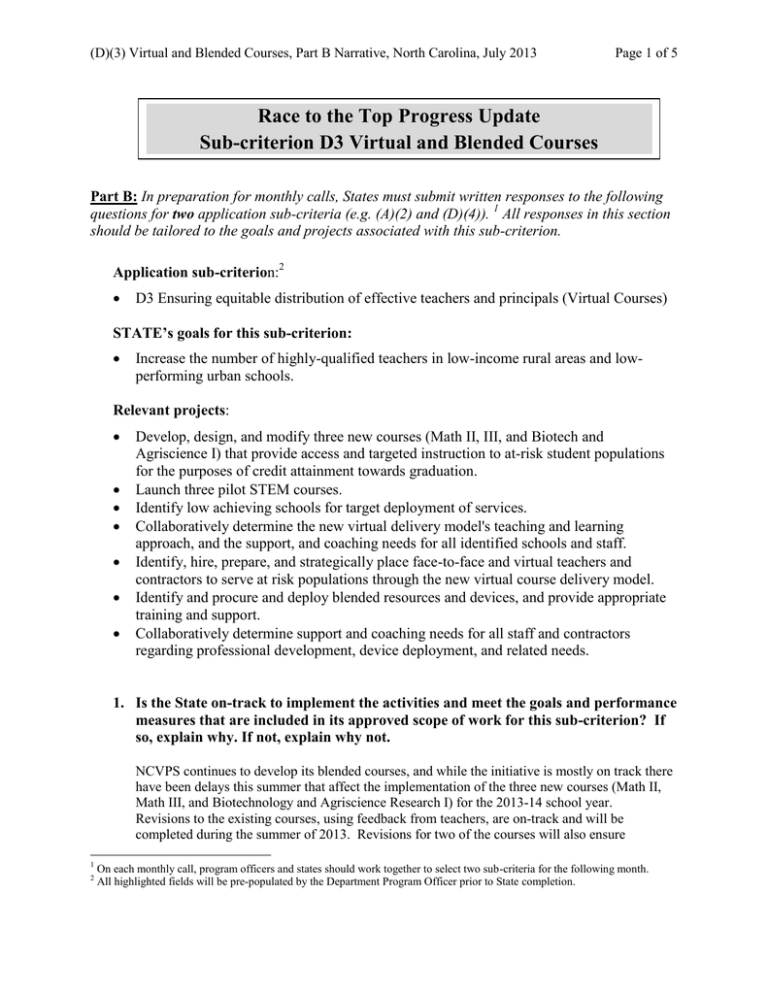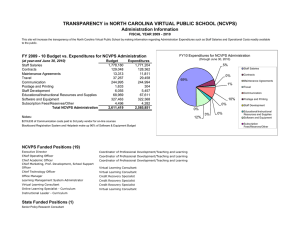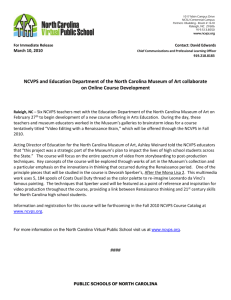Race to the Top Progress Update
advertisement

(D)(3) Virtual and Blended Courses, Part B Narrative, North Carolina, July 2013 Page 1 of 5 Race to the Top Progress Update Sub-criterion D3 Virtual and Blended Courses Part B: In preparation for monthly calls, States must submit written responses to the following questions for two application sub-criteria (e.g. (A)(2) and (D)(4)). 1 All responses in this section should be tailored to the goals and projects associated with this sub-criterion. Application sub-criterion:2 D3 Ensuring equitable distribution of effective teachers and principals (Virtual Courses) STATE’s goals for this sub-criterion: Increase the number of highly-qualified teachers in low-income rural areas and lowperforming urban schools. Relevant projects: Develop, design, and modify three new courses (Math II, III, and Biotech and Agriscience I) that provide access and targeted instruction to at-risk student populations for the purposes of credit attainment towards graduation. Launch three pilot STEM courses. Identify low achieving schools for target deployment of services. Collaboratively determine the new virtual delivery model's teaching and learning approach, and the support, and coaching needs for all identified schools and staff. Identify, hire, prepare, and strategically place face-to-face and virtual teachers and contractors to serve at risk populations through the new virtual course delivery model. Identify and procure and deploy blended resources and devices, and provide appropriate training and support. Collaboratively determine support and coaching needs for all staff and contractors regarding professional development, device deployment, and related needs. 1. Is the State on-track to implement the activities and meet the goals and performance measures that are included in its approved scope of work for this sub-criterion? If so, explain why. If not, explain why not. NCVPS continues to develop its blended courses, and while the initiative is mostly on track there have been delays this summer that affect the implementation of the three new courses (Math II, Math III, and Biotechnology and Agriscience Research I) for the 2013-14 school year. Revisions to the existing courses, using feedback from teachers, are on-track and will be completed during the summer of 2013. Revisions for two of the courses will also ensure 1 2 On each monthly call, program officers and states should work together to select two sub-criteria for the following month. All highlighted fields will be pre-populated by the Department Program Officer prior to State completion. (D)(3) Virtual and Blended Courses, Part B Narrative, North Carolina, July 2013 Page 2 of 5 alignment with new sets of standards: the Math I course ensure that it aligns to the revised Standard Course of Study, and the revisions for the Earth and Environmental Science course will align the material to the dare in line with the Next Generation Science Standards. These changes will be updated for use in courses for the fall of 2013. STEM Professional Development also continues to be offered for teachers, and has been moved into the Learning Management System to provide ease of access to face-to-face and virtual teachers. A calendar of opportunities for Professional Development is also present in the Learning Management System. In order to provide access to professional development, they are being converted to iBooks. This will provide teachers with mobile access to content without WIFI. The progress of teachers will be reported monthly to district liaisons, principals, and central office officials. NCVPS has experienced delays in hiring developers for the three courses scheduled for implementation at the start of the 2013-14 school year. As a result, Math II will be rolled out in a two-phase format as opposed to the whole course being available at the start of the semester. Part I at the start of the course in August will encompass 45-days of activities to ensure smooth transition into learning management system and allow teachers to begin working together; Part II of the course content will be available by October 4. NCVPS believes it will be able to secure developers for the additional courses (Math III and Biotechnology and Agriscience I) this fall and complete development in time to release the courses in the spring 2014 based on response from LEAs on student readiness and progress. This will bring the total number of courses for 2013-14 will be six full courses. The final two courses (a fourth math course and a second Biotechnology and Agriscience course) will start development in the fall of 2013 for scheduled launch in the fall of 2014. NCVPS is also working with STEM officials at NCDPI to determine the feasibility of utilizing content developed for STEM courses through the North Carolina School of Science and Math (NCSSM) in existing NCVPS courses. NCVPS would modify this for the blended format and make them available through their platform. NCVPS also continued to work to make content available to teachers and students in iBook format that allows off-line access. This change was made based on feedback from teachers and students, and has been integrated into the content development process. 2. Does the State have evidence indicating the quality of implementation for this subcriterion? What is/has the State doing/done as a result of this information? The main set of indicators for determining the quality of implementation comes from informal feedback collected by NCVPS staff and the pairs of teachers working together through the pilot. NCVPS Virtual STEM uses a mixture of virtual meetings and site visits to get feedback on implementation activities as they progress. For example, virtual and face-to-face teachers utilize Google Hangout sessions to participate in Professional Learning Network Meetings to share ideas and discuss challenges. Project leads meet (D)(3) Virtual and Blended Courses, Part B Narrative, North Carolina, July 2013 Page 3 of 5 weekly with all team members in a whole group meeting on Thursday nights at 8:00 pm and weekly with each team member to discuss feedback, tasks, and priorities. NCVPS staff members also conduct site visits to observe the implementation and gather feedback on integration and sustainability, and each virtual teacher has four spot checks a semester. The face-to-face teachers and virtual teacher communicate daily on issues, concerns, and successes through a daily log of information in order to monitor implementation of the course and make adjustments based on the needs of the students in the class. This is accessible to the STEM instructional leader and STEM project lead. Based on formative feedback provided through these methods, NCVPS has seen the following positive trends: Collaboration between virtual and face-to-face teachers is working well as they are using their daily logs to communicate about the course and face-to-face teachers took ownership of their role in the courses during the fall semester. There is better integration of mobile technology and applications within the courses. All teachers are using mobile applications better to allow students to create via the iPad. Face to face teachers are involving the iPad in their courses more and the virtual teachers are using multiple products, so students can use multiple applications to solve problems. This allows the student to develop their own answer based on information they have collected and understand. LEAs are examining the possibility of integrating courses into their general catalogue after the pilot phase has ended. Greene County, for example, is developing a STEM program which will include NCVPS virtual STEM courses. Face-to-face teachers are providing mentorship on Project Based Learning and integrating technology at local schools. This is occurring in staff meetings and in teacher-to-teacher dialogue. NCVPS is also conducting a “marks analysis” of courses. Teachers and NCVPS staff review grades from all courses and EOC data from sections of Math I to determine if strategies employed in the pilot implementations are helping students improve over the duration of the course. In addition to the informal feedback obtained through internal NCVPS procedures, a team from the Friday Institute at NC State has conducted an evaluation of the early implementation of the pilot, which will be released in the spring of 2013. Based on the preliminary findings, NCVPS staff made several changes to the courses such as providing iPad training for students and teachers within the course, two day training sessions in the Spring and Summer before course implementation for face-to-face teachers, development of multimedia help videos for suggestions of how to use applications on the iPad as it relates to course assignments, improved course development process, and focusing on teacher roles and communication. The informal and formal feedback has been used in the (D)(3) Virtual and Blended Courses, Part B Narrative, North Carolina, July 2013 Page 4 of 5 summer of 2013 to make revisions to the existing courses and for development of new courses. Some examples include: Reducing the number of grand challenges in first year courses from four to three to make room for additional instruction on concepts that students needed to know in order to meet standards (e.g., understanding the concept of ozone before discussing climate) Making aesthetic improvements to the Moodle pages in order to improve student’ ability to navigate the websites Purchasing additional developer tools to allow creation of animation and to caption videos for students Feedback has also been used to improve professional development offerings for teachers. This year NCVPS is working on more content-specific PD for teachers, creating a yearlong calendar to help teachers plan for sessions, and communicating monthly with central office and district personnel about these options to help make teachers aware of them. 3. What obstacles and/or risks could impact the State’s ability to meet its goals and performance measures related to this sub-criterion? Delays in hiring content developers for the new courses have necessitated pushing back full implementation of the two new courses scheduled to launch in the fall of 2014. The Math II course will have a two-phase rollout during the semester (see response to question one above), while Math III and Biotechnology and Agriscience I will not be available until the spring semester of 2014. These delays have also necessitated a twophase rollout of the Math II course in the fall of 213. The blended model requires a face-to-face teacher paired with a virtual teacher. The current LEAs are not able to divert additional personnel to the blended model in their schools, due either to the small size of the LEA and/or to budget cuts faced by the LEAs. Our current strategy to mitigate these challenges is to recruit several new schools to implement the blended model in a non-mobile blended environment. NCVPS is working to identify additional schools who may be interested in these courses and has continued to publicize them in the NCVPS catalog and through direct communication with LEAs. A third challenge involves the development of a mobile application that can allow access to the STEM courses. This development is in the draft phase and being reviewed by the State ITS Project Manager and Virtual STEM Technology Liaison. This process requires meeting State ITS reporting standards before being posted as a request for proposal. There are multiple levels of the review, meaning that the process is more time consuming than originally anticipated. The review process has continued to move forward since the (D)(3) Virtual and Blended Courses, Part B Narrative, North Carolina, July 2013 Page 5 of 5 site visit in April, though the State ITS Project Manager has not approved the release of the RFP yet. Evaluation: Based on the responses to the previous question, evaluate the State’s performance and progress to date for this sub-criterion (choose one) Red (1) 3 Orange (2) Yellow (3) Green (4)3 Red – substantially off-track and/or has significant quality concerns; urgent and decisive action is required; Orange –off-track and/or there are quality concerns; many aspects require significant attention; Yellow –generally on-track and of high or good quality; only a few aspects require additional attention; Green – on-track with high quality.

